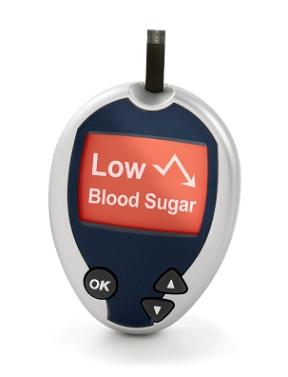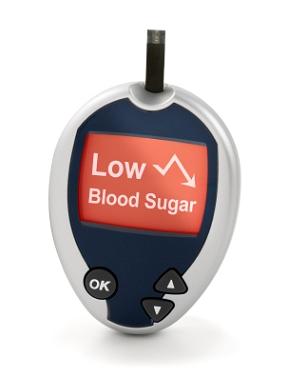
Low blood sugar, also known as hypoglycemia, can be a dangerous condition. Low blood sugar can happen in people with diabetes who take medicines that increase insulin levels in the body. Taking too much medication, skipping meals, eating less than normal, or exercising more than usual can lead to low blood sugar for these individuals.
Blood sugar is also known as glucose. Glucose comes from food and serves as an important energy source for the body. Carbohydrates — foods such as rice, potatoes, bread, tortillas, cereal, fruit, vegetables, and milk — are the body’s main source of glucose.

After you eat, glucose is absorbed into your bloodstream, where it travels to your body’s cells. A hormone called insulin, which is made in the pancreas, helps your cells use glucose for energy. If you eat more glucose than you need, your body will store it in your liver and muscles or change it into fat so it can be used for energy when it’s needed later.
Without enough glucose, your body cannot perform its normal functions. In the short term, people who aren’t on medications that increase insulin have enough glucose to maintain blood sugar levels, and the liver can make glucose if needed. However, for those on these specific medications, a short-term reduction in blood sugar can cause a lot of problems. Your blood sugar is considered low when it drops below 70 mg/dL. Immediate treatment for low blood sugar levels is important to prevent more serious symptoms from developing.
What are the symptoms of low blood sugar?
Symptoms of low blood sugar can occur suddenly. They include:
- blurry vision
- rapid heartbeat
- sudden mood changes
- sudden nervousness
- unexplained fatigue
- pale skin
- headache
- hunger
- shaking
- dizziness
- sweating
- difficulty sleeping
- skin tingling
- trouble thinking clearly or concentrating
- loss of consciousness, seizure, coma
People with hypoglycemic unawareness do not know their blood sugar is dropping. If you have this condition, your blood sugar can drop without you noticing it. Without immediate treatment, you can faint, experience a seizure, or even go into a coma.
Very low blood sugar is a medical emergency. If someone you know has diabetes and they’re experiencing mild to moderate symptoms, have them eat or drink 15 grams of easily digestible carbohydrates, such as:
half a cup of juice or regular soda
1 tablespoon of honey
4 or 5 saltine crackers
3 or 4 pieces of hard candy or glucose tablets
1 tablespoon of sugar
If someone is having a severe reaction, such as unconsciousness, it’s important to administer a medication called glucagon and contact emergency services immediately. People who are at risk for low blood sugar should talk to their doctor about getting a prescription for glucagon. You should never give an unconscious person anything by mouth, as it could cause them to choke.
What causes low blood sugar?
Low blood sugar can occur for a number of reasons. It’s usually a side effect of diabetes treatment.
Diabetes and low blood sugar
Diabetes affects your body’s ability to use insulin. Think of insulin as the key that unlocks your cells, letting glucose in for energy. People with diabetes use a variety of treatments to help their bodies use the glucose in their blood. Among these are oral medications that increase insulin production and insulin injections.
| Everything You Must Know about Diabetes |
If you take too much of these types of medications, your blood sugar may drop too low. People also sometimes experience low blood sugar when planning to eat a big meal, but then they do not eat enough. Skipping meals, eating less than normal, or eating later than normal but taking your medication at your normal time can also lead to low blood sugar levels.
Unplanned excess physical activity without eating enough can also cause a drop in blood sugar levels.
Drinking alcohol when you’re on these medications can also lead to low blood sugar, especially if it replaces food. When the body is trying to get rid of alcohol it becomes worse at managing blood sugar levels.
Other causes of low blood sugar
You don’t have to have diabetes to experience low blood sugar. Some other causes of low blood sugar include:
- certain medications, such as quinine
- some medical conditions, such as hepatitis or kidney disorders
- a tumor that produces excess insulin
- endocrine disorders, such as adrenal gland deficiency
How is low blood sugar diagnosed?
If you suspect you have low blood sugar, it’s important to check your blood sugar right away. If you don’t have a meter and you’re on diabetes medications that increase insulin, talk to your doctor about getting a blood glucose meter. If you experience low blood sugar often — say, a few times a week — see your doctor right away to determine why. Your doctor will begin your visit by taking your medical history, asking questions about your eating habits, and learning more about the symptoms you’re experiencing.
If you don’t have diabetes but suspect you have hypoglycemia, talk to your doctor about your symptoms. They will perform a physical examination. They will use three criteria, sometimes referred to as “Whipple’s triad,” to diagnose low blood sugar. These include:
Signs and symptoms of low blood sugar: Your doctor may require you to fast, or abstain from drinking and eating for an extended period of time, so they can observe your low blood sugar signs and symptoms.
Documentation of low blood sugar when your signs and symptoms occur: Your doctor will perform a blood test to analyze your blood sugar levels in a laboratory.
Disappearance of the signs and symptoms of low blood sugar: Your doctor will want to know whether the signs and symptoms go away when your blood sugar levels are raised.
Your doctor may send you home with a blood glucose meter — a small, handheld blood testing device — to track your blood sugar over time at home. They will give you instructions to test your blood sugar during certain times of the day, such as after waking up and after eating meals. To perform a blood sugar test, you will need to prick your finger with a lancet (provided in your blood glucose test kit). You’ll put a small sample of blood from this onto a strip inserted into the blood glucose meter.
If you don’t have a blood sugar testing machine on hand and are experiencing signs or symptoms of low blood sugar with diabetes, those symptoms may be enough to diagnose low blood sugar. Be sure to treat it right away. Use the tips for eating 15 grams of carbohydrate described above. Test again in 15 minutes, and if your blood sugar is not increasing, treat with another 15 grams of carbs. If your blood sugar remains unresponsive, contact your doctor or emergency services. When in doubt, treat.
Symptoms of low blood sugar usually get worse if they’re left untreated. Make an appointment to see a doctor if you have diabetes and experience low blood sugar levels often, or if you have symptoms, even if you don’t have diabetes.
How are low blood sugar levels treated?
When your blood sugar levels are too low, eating something made of carbohydrates is key. If you have diabetes, try to keep high-carbohydrate snacks on hand. The American Diabetes Association recommends that your snack have at least 15 grams of carbohydrates. Some good snacks to keep on hand include:
- granola bars
- fresh or dried fruit
- fruit juice
- pretzels
- cookies
You also can take glucose tablets to rapidly raise your blood sugar if it’s low. These are available without a prescription. It’s important to check how many grams are in each tablet before taking them. Aim to get 15 to 20 grams of carbohydrates.
Wait 15 minutes after eating or taking a glucose tablet, and test your blood sugar again. If your blood sugar is not going up, eat another 15 grams of carbohydrates or take another dose of glucose tablets. Repeat this until your blood sugar level starts to rise. If your regularly scheduled meal is not for a while, eat a small snack after the low blood sugar episode.
Be sure not to overeat! This could lead to blood sugar levels that are too high.
Complications from spells of low blood sugar
Mildly low blood sugar levels are somewhat common for people with diabetes; however, severely low blood sugar levels can be life-threatening. They may lead to seizures and nervous system damage if left untreated long enough. Immediate treatment is critical. It’s important to learn to recognize your symptoms and treat them fast. For people at risk of low blood sugar, having a glucagon kit — a medication that raises blood sugar levels — is important. Talk to your doctor for more information.
You may also want to talk with friends, family members, exercise partners, and coworkers about how to care for you if your blood sugar drops too low. They should learn to recognize low blood sugar symptoms and know how to use the glucagon kit, as well as understand the importance of calling 911 if you lose consciousness.
Wearing a medical identification bracelet is a good idea. It can help emergency responders care for you properly if you need emergency attention.
Treat low blood sugar as soon as possible. Avoid driving if you are experiencing low blood sugar, as it can increase your risk of having an accident.
Source :-HealthLine

Leave a Reply